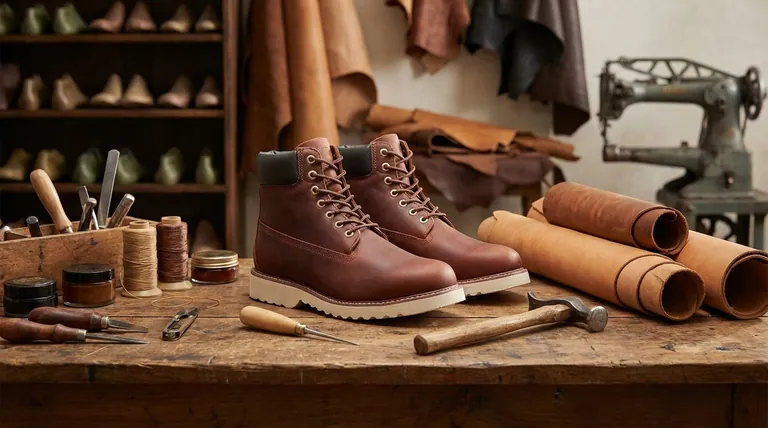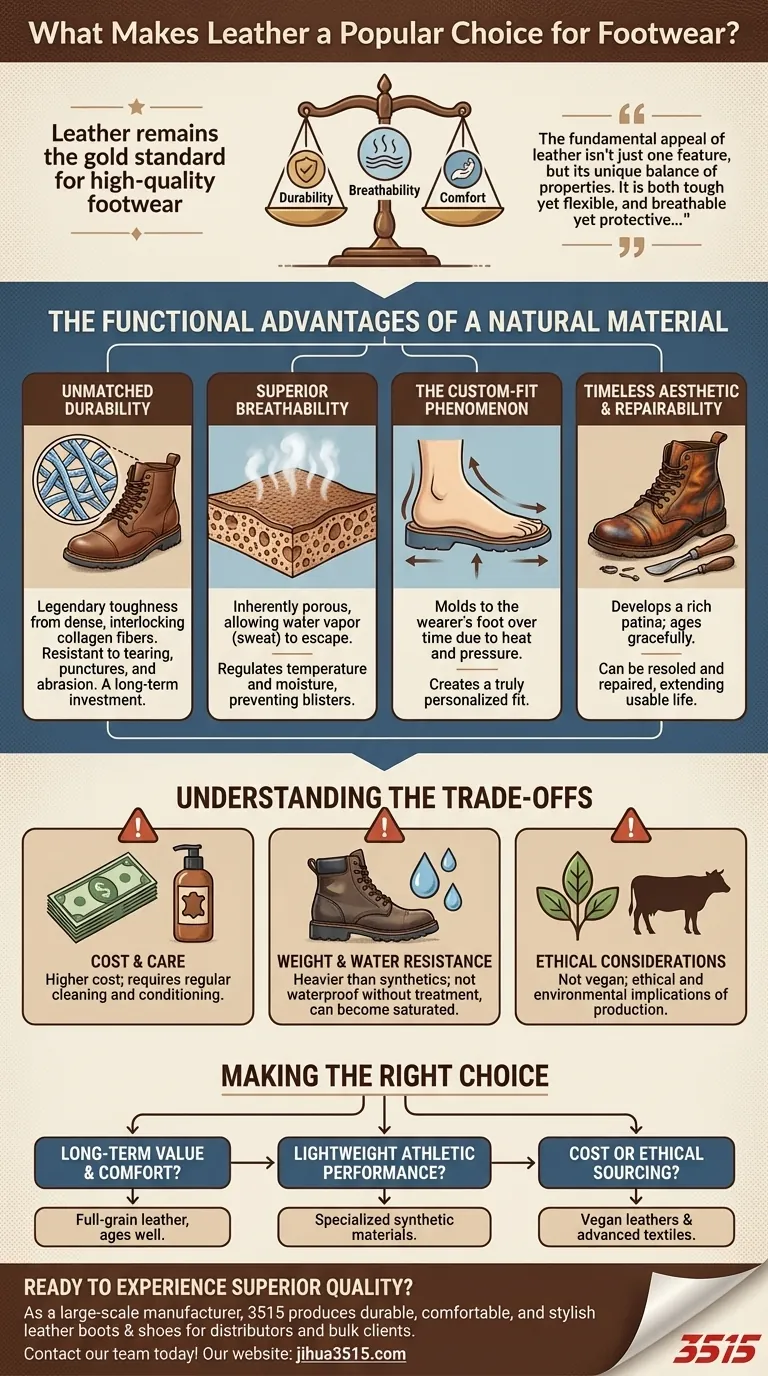Leather remains the gold standard for high-quality footwear for a simple reason: it delivers a unique combination of durability, breathability, and comfort. Unlike static synthetic materials, leather is a natural material that adapts to the wearer, creating a personalized fit that improves over time.
The fundamental appeal of leather isn't just one feature, but its unique balance of properties. It is both tough yet flexible, and breathable yet protective, a combination that is exceptionally difficult to replicate synthetically.

The Functional Advantages of a Natural Material
The reason leather has been used for millennia in footwear is rooted in its inherent physical structure. As a natural skin, it possesses characteristics that are ideal for protecting the human foot while ensuring comfort.
Unmatched Durability
Leather's legendary toughness comes from its dense, interlocking web of collagen fibers. This natural structure is highly resistant to tearing, punctures, and abrasion, far surpassing most textiles.
This means a well-made leather shoe can withstand years of daily wear, making it a long-term investment rather than a disposable item.
Superior Breathability
Because leather is a natural skin, it is inherently porous. These microscopic pores allow water vapor—sweat—to pass from inside the shoe to the outside.
This breathability is critical for regulating temperature and moisture, keeping feet drier and more comfortable while helping to prevent blisters and fungal infections. Most synthetic materials lack this quality, often trapping heat and sweat.
The Custom-Fit Phenomenon
Perhaps leather's most prized quality is its ability to mold to the wearer's foot. Over time, the heat and pressure from your foot cause the leather's fiber structure to stretch and re-form.
This process creates a truly custom fit, accommodating the unique shape of your foot and providing a level of personalized comfort that rigid, man-made materials cannot match.
Timeless Aesthetic and Repairability
Leather develops a rich patina with age, a visual characteristic that is highly valued. Unlike synthetic materials that often crack and degrade, quality leather ages gracefully.
Furthermore, high-quality leather footwear can often be resoled and repaired by a cobbler, significantly extending its usable life far beyond that of a typical synthetic shoe.
Understanding the Trade-offs
No material is perfect. The same properties that make leather exceptional also introduce specific responsibilities and considerations for the owner.
The Investment of Cost and Care
High-quality leather is more expensive than synthetic alternatives due to the complex tanning and finishing processes required.
It also requires maintenance. To retain its strength and flexibility, leather must be regularly cleaned and conditioned to replenish its natural oils and prevent it from drying out and cracking.
Weight and Water Resistance
The dense fiber structure that makes leather durable also makes it heavier than many modern synthetic textiles used in athletic footwear.
While naturally water-resistant to a degree, most leather is not waterproof without specialized treatments or the inclusion of a waterproof membrane. It can become saturated and heavy if exposed to significant moisture for prolonged periods.
Ethical Considerations
As an animal product, leather is not a vegan material. For many consumers, the ethical and environmental implications of its production are a primary factor in their purchasing decisions.
Making the Right Choice for Your Footwear
Understanding these core properties allows you to select footwear that aligns perfectly with your needs.
- If your primary focus is long-term value and personalized comfort: A well-constructed, full-grain leather shoe is an unparalleled investment that improves with age.
- If your primary focus is lightweight athletic performance: Specialized synthetic materials will likely offer better performance characteristics for running or sports.
- If your primary focus is cost or ethical sourcing: Modern vegan leathers and advanced textile options are the most suitable choice.
Ultimately, choosing leather is choosing a material that works with your body, offering a blend of natural performance and enduring style that few alternatives can match.
Summary Table:
| Key Property | Why It Matters for Footwear |
|---|---|
| Durability | Resists tearing and abrasion for long-lasting wear. |
| Breathability | Allows moisture vapor to escape, keeping feet dry. |
| Moldable Fit | Conforms to the shape of your foot for personalized comfort. |
| Timeless Aesthetic | Develops a rich patina and can often be repaired. |
Ready to experience the superior quality of genuine leather footwear?
As a large-scale manufacturer, 3515 produces a comprehensive range of durable, comfortable, and stylish leather boots and shoes for distributors, brand owners, and bulk clients. Our expertise ensures you receive footwear that combines timeless appeal with exceptional performance.
Contact our team today to discuss your footwear needs and discover how we can add value to your business.
Visual Guide

Related Products
- Wholesale Leather Work Boots with Customizable Wedge Sole for Brands
- Durable Leather Tactical Boots Wholesale & Custom Manufacturing for Brands
- Durable Leather Work Boots for Wholesale & Custom Manufacturing
- Durable Leather Work Boots for Wholesale & Custom OEM Manufacturing
- Durable Goodyear Welt Leather Work Boots for Wholesale & Private Label
People Also Ask
- What protection do leather work boots need? A Complete Guide to Material Care and Worker Safety
- What is the complete process for deep cleaning leather work boots? A Step-by-Step Guide to Preserve Your Investment
- How should new leather work boots be broken in? A Guide to Comfort and Durability
- What are the best practices for storing leather work boots? Preserve Your Investment for Years
- How does cleaning your work boots help in their maintenance? Extend Lifespan & Boost Safety



















